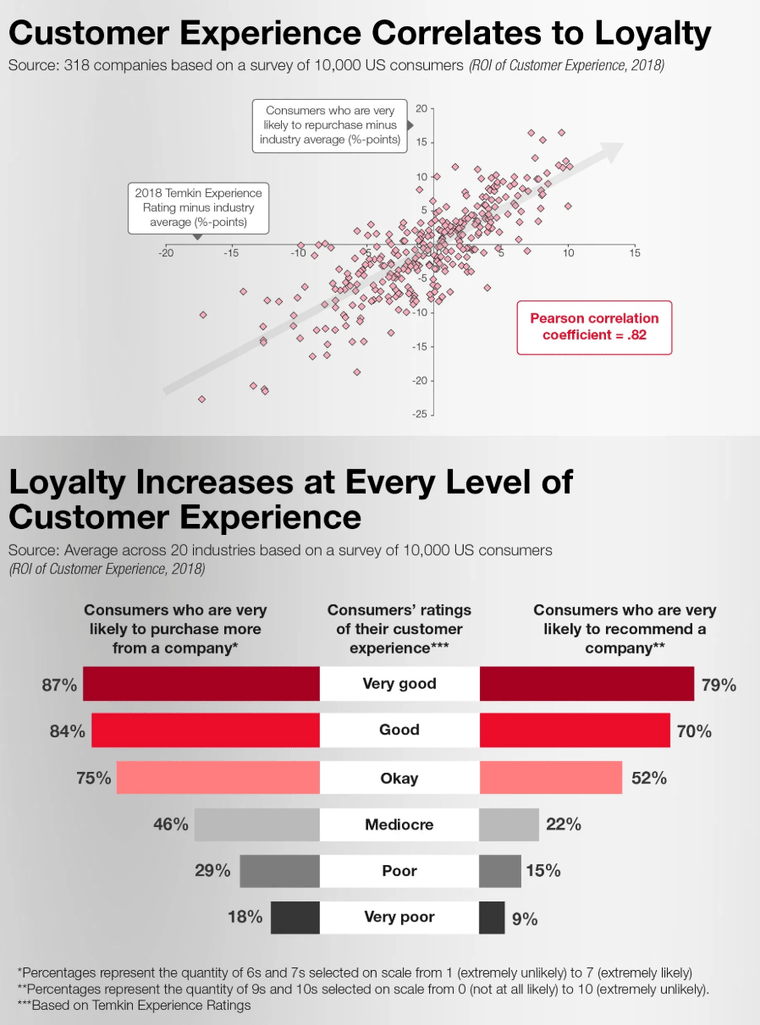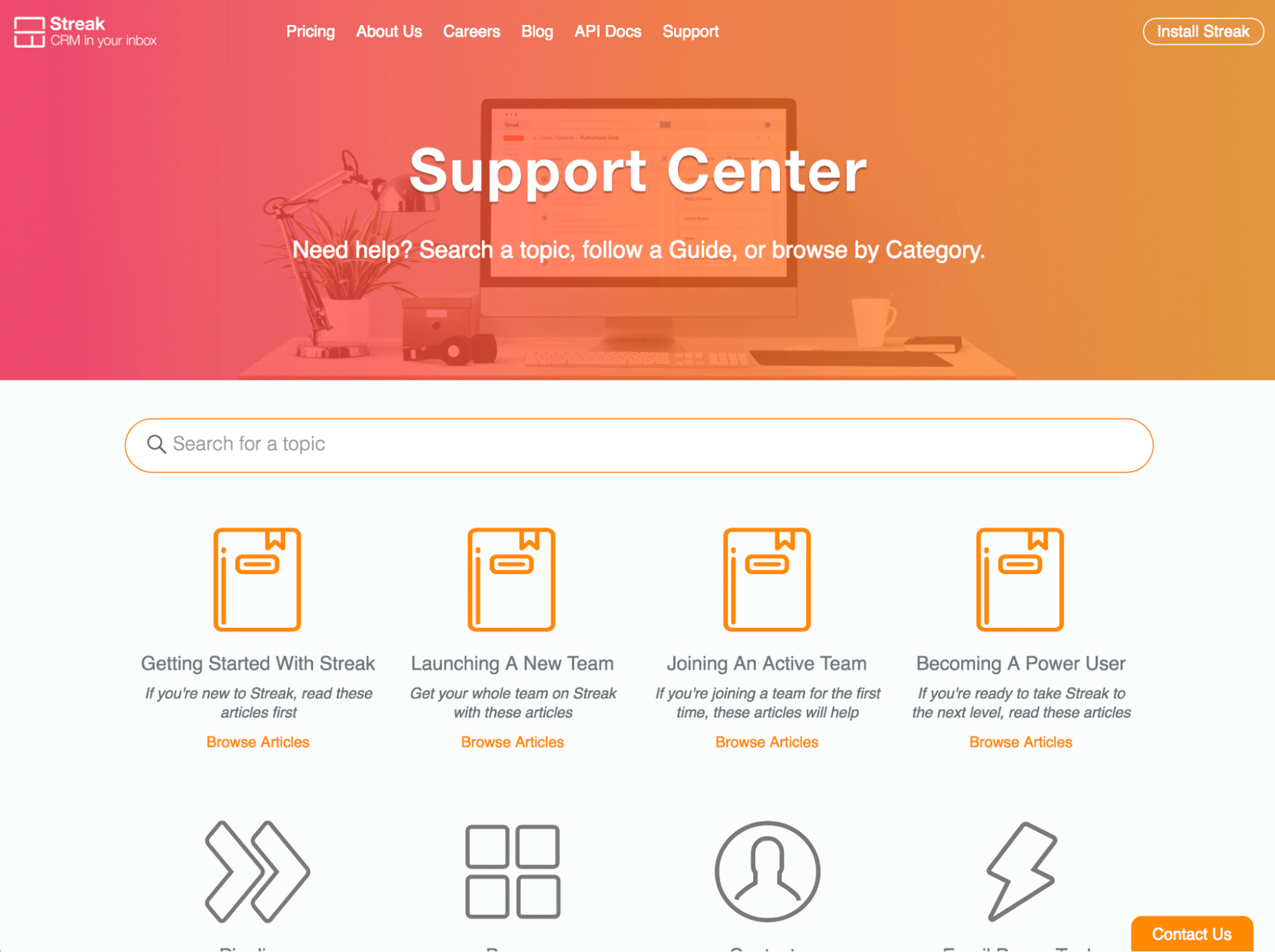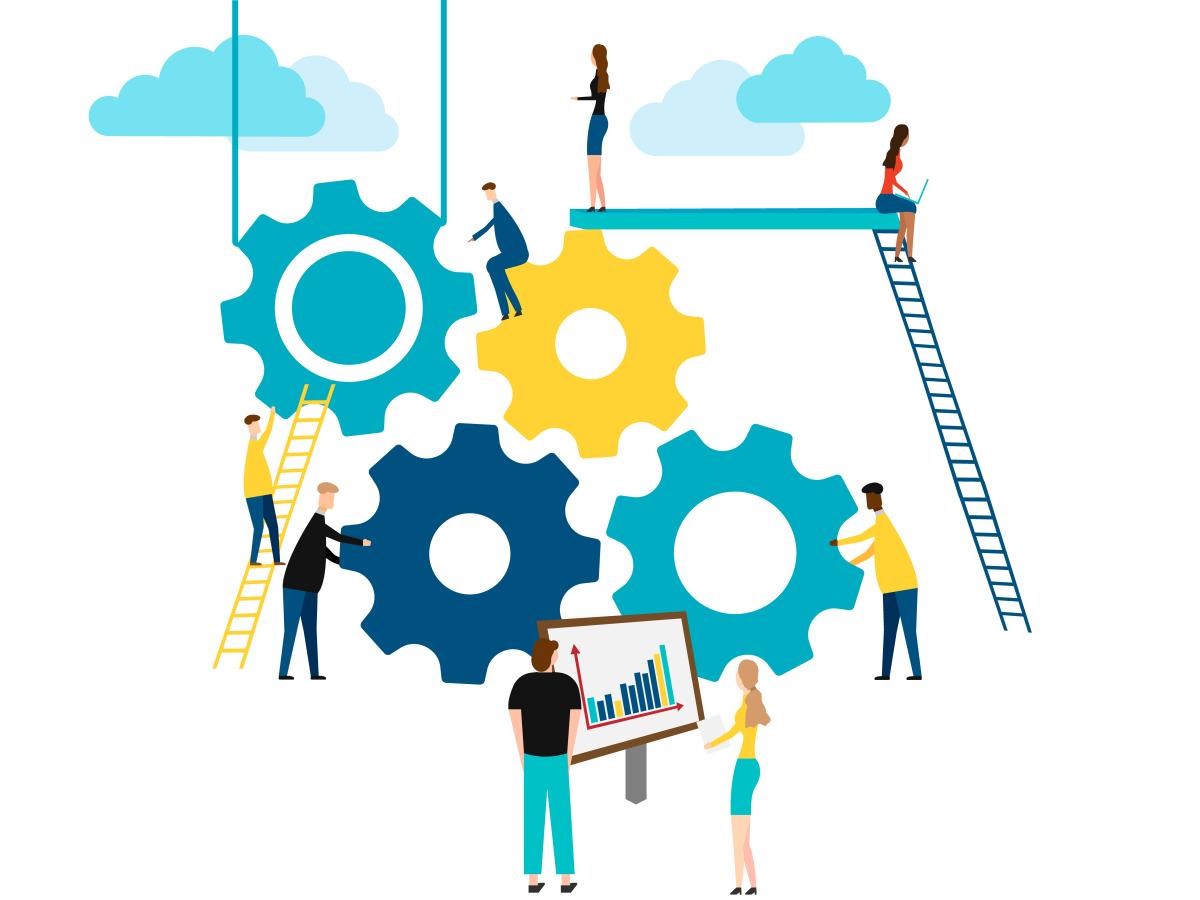It’s not a stretch to say that providing a positive customer experience is a top priority for brands today.
Case in point, 67% of consumers admit their standards related to customer experience are higher than ever before.
Additionally, 76% of consumers seek out brands that truly understand and provide for their specific needs and expectations.
Companies that are able to meet (and exceed) their customers’ CX-related expectations stand to reap a number of rewards, including increased engagement, retention, and evangelism.
Need proof? Take a look at this infographic from the Temkin Group:

(Source)
Unfortunately, Temkin Group’s data also shows that providing a subpar customer experience can cause irreparable damage to your relationship with your audience:

(Source)
Now, it’s not uncommon for companies to see all this data and begin thinking of ways to completely transform their customer experience. After all, being known as a revolutionary innovator in your industry is bound to generate some buzz for your brand, right?
Ironically, in an effort to revolutionize the experience they provide their customers, many brands are failing to meet their audience’s basic needs.
As it turns out, most consumers look to brands that provide the simplest and easiest path to progress. When engaging with their favorite brands, consumers want to be able to accomplish their goals with as little friction as possible.
Put simply, the quality of your CX hinges on your ability to bring your customers from Point A to Point B—whatever that might mean for the individual consumer.
With that in mind, today we’re going to talk about how a strong knowledge management system can help you provide a streamlined experience to your customers in a variety of ways.
First, let’s explain what a knowledge management system is.
What is a Knowledge Management System?
The terms knowledge management system (KMS) and knowledge base (KB) are often used interchangeably—but this isn’t entirely accurate. Rather, a knowledge base is only one part of a more overarching knowledge management system.
An organization’s overall KMS may also include other types of knowledge management software like:
- A wiki-style information database
- On-site FAQ pages
- Knowledge base
- Training programs and webinars
- Case studies, white papers, and other informational content
- CRM databases
In many cases, the information presented within a KMS is meant to directly provide value to the customer.
In other cases, said knowledge is meant to be used by employees in ways that indirectly provide added value to the customer’s experience.
In either case, the end goal is to enhance the customer experience in some way or another through the use of relevant knowledge and information.
5 Ways a Knowledge Management System Can Improve Customer Experience
A comprehensive and functional knowledge management system is vital to your efforts to improve CX.
Let’s take a closer look at some of the ways knowledge management ultimately leads to a better experience for your customers.
1. Knowledge Management Systems Create Alignment Within Your Team
A 2016 report by the Temkin Group found that brands leading the charge in providing a top-notch CX have 1.5x as many engaged employees than their lagging counterparts.
According to Quantum’s 2016 Employee Engagement Trends report, creating this engagement involves:
- Providing opportunities for teams to communicate and collaborate
- Developing mutual trust between teams and individual employees
- Aligning employees and teams toward a common goal
A proper knowledge management system is an essential asset when it comes to making these things happen.
From a practical perspective, a KMS makes it easy for all team members to stay on the same page at all times:
- All team members have access to a singular, up-to-date database of information
- Individuals will know who’s responsible for what throughout a given initiative
- All involved parties understand the overall goal(s) for a given initiative
This, in turn, allows your various teams to communicate and collaborate more effectively across the board. Since everyone’s on the same page to begin with, collaborating parties can get started immediately, rather than having to catch each other up in some way or another.
(It’s also worth mentioning that KMS’ typically include technology that facilitates communication and collaboration. So, a KMS is also essential in that it actually enables quick and easy communication in the first place.)
A proper KMS also better enables teams to become more aligned with the organization’s overall mission.
Because the knowledge within your KMS will often address the “why” behind your processes, your team members will come to understand their true purpose within your organization. As a recent report from TinyPulse shows, this leads to increased employee engagement—which, again, often culminates in an improved CX.
A robust knowledge management system allows your teams and individual employees to stay aligned at all times. In turn, this makes it easy for them to work together in order to provide the best possible experience to your customers.
2. KM Systems Allow for Streamlined Processes
Piggybacking off of the above, a comprehensive knowledge management system removes friction for your various teams as they go about their duties.
In fact, a 2017 study from the Journal of Knowledge Management found a clear relationship between the use of a KMS and a team’s productivity levels:
“Results show a strong relationship between knowledge management practices and intermediate activities of creative problem solving and problem-solving speed. In addition, creative problem solving has a direct impact on both organizational and financial performances (with speed impacting only financial performance).”
As a repository of explicit, implicit, and even tacit knowledge, a KMS provides your various teams with clear guidance as to the best course of action for almost any given scenario they may encounter.
A few examples:
- Your marketing team will have access to information about your products or services, along with data regarding your target customers’ pain points, personas, and other factors. In turn, they can create marketing content that showcases how your offering addresses your audience’s situation in full.
- Your sales team will have up-to-the-minute information on your individual customers (e.g., their lead score, sales funnel position, recent engagements, etc.). This can allow them to further personalize (even individualize) the CX for each customer they engage with.
- Your service and support teams can use whatever info they need from your KMS to help your struggling customers overcome any problems they may be facing. They’ll also have access to your individual customers’ engagement histories, and can use this info as needed throughout the problem-solving process.
As we mentioned in the intro, the modern customer is all about finding the simplest and easiest solution to the problems they face.
With a proper KMS in place, the path of least resistance (for both your teams and your customers) will be crystal clear. In turn, your customers will have a positive experience each and every time they engage with your brand.
3. KM Systems Enable Customer Self-Service
As noted earlier, many parts of a complete knowledge management system are customer-facing in nature.

A company’s knowledge bases, FAQ pages, and other informational content provide customers multiple opportunities to solve their individual problems without much assistance.
Which is exactly what the modern customer wants.
Case in point, Zendesk found that half of consumers want to be able to solve product- or service-related issues by themselves, while 70% expect brands to provide a self-service portal (such as a knowledge base).
There are actually three levels to the benefits of providing multiple self-service options via a KMS:
- The first level is quite simple: If your customers say they expect a self-service portal, they want a self-service portal. If you give them what they want, their experience with your brand will improve. Period.
- Digging a bit below the surface, the self-service portions of a KMS enable the customer to achieve their current goals (or overcome their current obstacles) more effectively and efficiently. This means fewer frustrations (e.g., waiting on hold, being transferred, etc.), and more successful engagements for your customers most in need.
- Going much deeper, the fact that your KMS enables your customers to have such a positive experience will further enhance their CX in a “meta” sort of way. Since your KMS always provides the exact information your customers are looking for, their trust in your brand will continue to grow each time they use it.
Of course, this all assumes that your customer-facing KMS is comprehensive, providing as much information and instruction to your audience as you possibly can.
4. KM Systems Better Enable Your Service and Support Teams
...But, to be sure, knowledge management systems can’t help the customer solve all of their problems.
But, they can ensure your support staff will be better equipped to help them when the need arises.
In the first place, because your KMS allows for some level of self-service, your team won’t need to spend excess time and energy working through these issues with the customer. It’s a “teach a man to fish” moment: By giving your customers the information they need to solve a problem, your team won’t need to help them solve the problem every time they encounter it.
In turn, your support staff will have more time and energy to invest in solving the problems that do require a more hands-on approach. In more effectively alleviating these more major issues for the customer, your support staff can completely change said customer’s experience with your brand—both in the specific instance and overall.
And, as we said earlier, your support team can also use your KMS to more effectively solve your customers’ issues. Whether by accessing the right information at the right time, or collaborating with various team members at various times, your support staff’s use of your KMS will ultimately benefit the customers most in need of your services.
For a real-world example of how a comprehensive KMS can benefit your business, check out the story of how RMS Cloud’s knowledge base resolves up to 75% of daily customer inquiries with no interaction needed.
As the team at RMS explains, this creates a “significant decrease on overall support calls, and gives the team more time to focus on proactive interactions with their customer portfolios.”
5. Knowledge Management Systems Enable Cyclical Improvement
So far, we’ve talked about all the ways your team and your customers can use a knowledge management system to improve the customer experience.
Now, let’s focus on how reflecting on how your team and your customers use your KMS can allow to make improvements to your CX.
Okay, that was a lot to take in; let’s break it down a bit further.
First, there’s a lot to gain from assessing how your various teams use your KMS. For one thing, you can see which tools and resources they rely on most—a sign that you should ensure these resources are as robust and/or efficient as possible. Additionally, this allows you to identify and eliminate any redundancies or inefficiencies within your KMS (and related processes, as well).
Secondly, the way in which your customers engage with your KMS can provide insight into your customers’ needs and expectations (and your team’s ability to meet them).
For example, say you find that a certain page or topic on your knowledge base is getting massive amounts of traffic. This, potentially, could mean a few different things, such as:
- Your audience is looking for even deeper content on the topic in question
- Your audience finds the current content incredibly helpful and valuable
- The related product or service you offer is lacking in a certain area, causing your customers to seek additional assistance
(Of course, figuring out which is the case will require that you dive much deeper into the situation at hand. To make this deeper dive, you’ll want to use a feedback tool to help you engage further with your customers.)
At any rate, once you determine the meaning behind your customers’ engagements with your KMS, you can begin making improvements as necessary. Using the example above, you might decide to:
- Revamp the content in question to provide more specific detail and comprehensive instruction
- Revamp your other content to match the quality of your more engaging content
- Make iterative changes to your product or service to eliminate the most common problems your customers face when using it
In each case, the goal is simple:
Improve customer experience, and provide more value to the customer.
By assessing how your team and customers use your KMS, you’ll have a pretty clear idea of what your organization’s next steps should be at all times.
In turn, you’ll be able to make improvements to your customer experience that truly matter to your customers.

